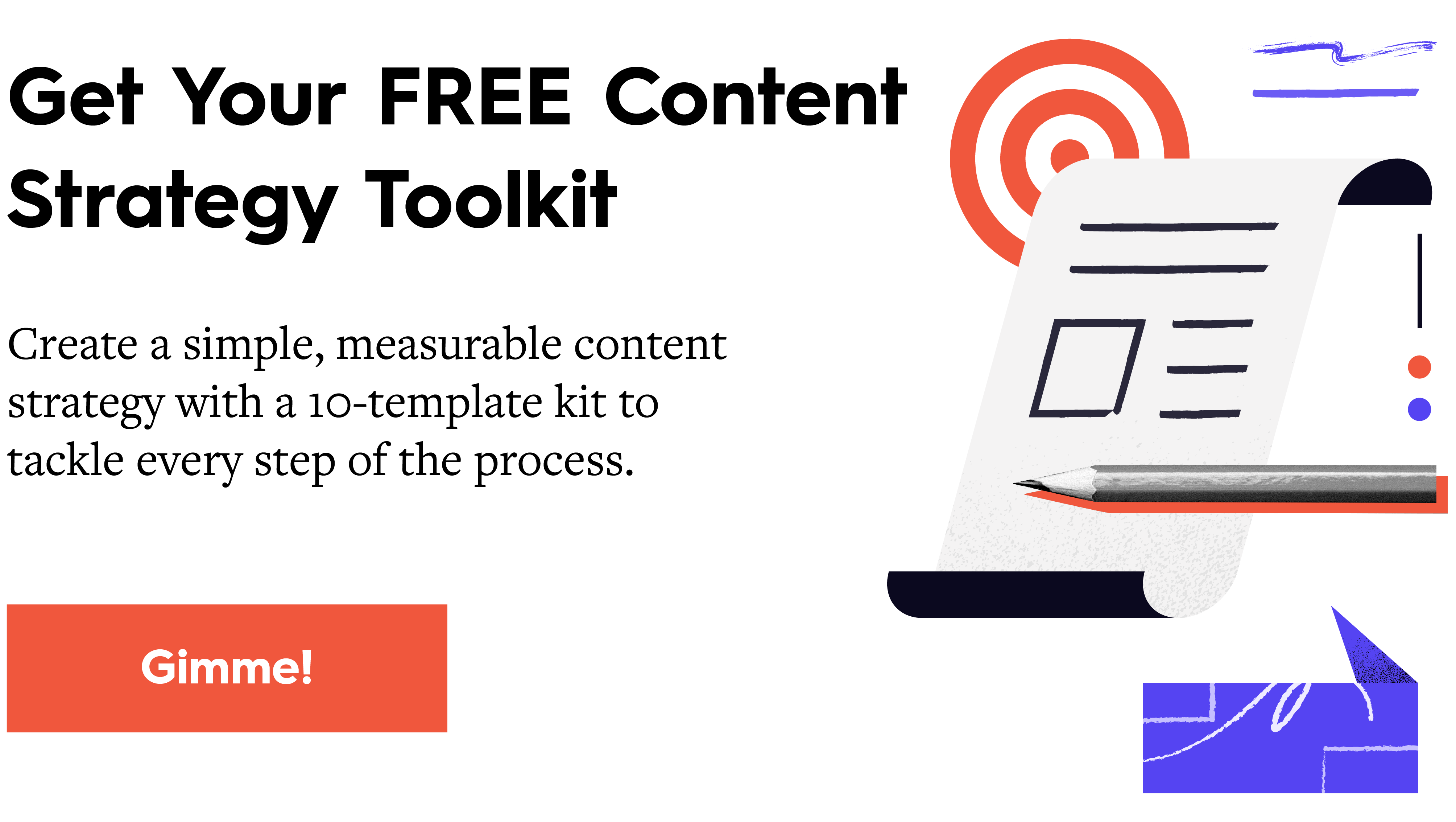It’s a chaotic time in content marketing. Budgets are shrinking. Markets keep shifting. AI is changing the way we work. You need to deliver more with less, which means you need to improve your content marketing ROI as much as possible.
But how do you do that effectively when measuring ROI can feel so messy? What metrics should you track? What formula should you use? What goals should you set?
The first step is getting clarity on what ROI looks like, how you’ll measure it, and which steps will actually improve your results. The good news? Many of those steps are lighter lifts than they seem.
But first, a primer in all things ROI.

What Is Content Marketing ROI?
Content marketing ROI measures the financial return you get from content compared to what you spend creating and distributing it.
The basic formula: (Revenue Generated – Content Investment) ÷ Content Investment × 100. For example, if you spent $10,000 on content and it generated $30,000 in revenue, your ROI is 200%.
But here’s where it gets real: What counts as “revenue generated” from content? Unlike a direct sale, content often plays a supporting role across multiple touchpoints. Someone might read three blog posts, download a whitepaper, attend a webinar, and convert six months later. Which piece gets credit?
That’s why measuring content marketing ROI requires more than a single formula.
How to Measure Content Marketing ROI
To get a clear picture of your ROI, you need to identify what you’ll measure and how you’ll measure it, according to your needs and goals. Here’s our simple step-by-step guide to choose the right measurement for your brand and make data-informed decisions going forward.
1. Determine how you’ll define ROI.
Ultimately, you need to identify what “return” means for your business and how to track it accurately. There are several ways to view this.
- Gross Profit ROI: This accounts for cost of goods sold to give you a more realistic profit picture. The formula: (Gross Profit – Marketing Investment) ÷ Marketing Investment × 100.
- Customer Lifetime Value (CLV) Method: This is the total value a customer brings over their relationship with your company. The formula: (Average Customer Value × Average Customer Lifespan – Content Investment) ÷ Content Investment × 100. For example, if content attracts customers worth $50,000 over three years and you spent $5,000 acquiring them, that tells a different story than a $2,000 one-time purchase.
- Revenue Influence Model: This attributes a percentage of revenue to content based on its role in the buyer journey. The formula: (Total Revenue from Deals Where Content Was Present × Attribution Weight) – Content Investment) ÷ Content Investment × 100. For example, if $500,000 in closed deals involved content interactions, and you assign 30% influence to content (based on sales feedback or multi-touch attribution data), that’s $150,000 in content-influenced revenue. If you spent $25,000 on content, your ROI is 500%. This is less precise, as it requires an assigned attribution weight, but it captures content’s assist value across multiple touchpoints.
However, remember that return isn’t always direct revenue. Depending on your goals, content ROI might include:
- Direct revenue: Sales attributed to specific content, such as ebooks that convert to purchases or product comparison posts that drive conversions.
- Lead value: If you know your lead-to-customer rate and average deal size, you can calculate content-generated lead value. A whitepaper generating 100 qualified leads worth $1,000 each creates $100,000 in pipeline value.
- Cost savings: Content that reduces support tickets, cuts sales cycle length, or decreases customer acquisition cost delivers ROI through efficiency.
- Brand equity: Measurable through brand awareness surveys, search volume for branded terms, and organic traffic growth. These lead to future revenue even if they don’t convert today.
The method you choose depends on your business model, sales cycle, and what you’re trying to optimize.
2. Identify the metrics for tracking content marketing ROI.
Metrics are the key to connect your content activity to business outcomes. Without them, you’re flying blind. These are some of the more common metrics that contribute to ROI.
Traffic and Engagement Metrics
- Organic sessions: Total visits from search engines. Rising organic traffic suggests your content strategy is working with SEO.
- Pages per session: How many pages people view in one visit. Higher numbers suggest engaging content that keeps people exploring.
- Time on page: How long people spend with individual pieces. Longer times on in-depth guides signal value.
- Scroll depth: How far down the page people read. If 80% bail before reaching your CTA, you’ve got a content problem.
- Return visitor rate: How many people come back. High return rates suggest you’re building an audience, not just capturing one-time clicks.
Conversion Metrics
- Conversion rate: Percentage of visitors completing desired actions. Track this by content type and topic to identify what drives action.
- Assisted conversions: Content that appears in the conversion path but isn’t the final touchpoint still deserves credit.
- Lead generation: Total leads attributed to content. Track both quantity and quality because 100 low-intent leads aren’t worth 10 qualified prospects.
- Content downloads: Gated assets like ebooks and templates often indicate higher intent than passive content consumption.
Revenue and Financial Metrics
- Revenue attribution: Total revenue linked to content interactions. This requires solid tracking and attribution models.
- Customer Acquisition Cost (CAC): How much you spend to acquire each customer through content. Lower CAC means better efficiency.
- Customer Lifetime Value (CLV): Total revenue a customer generates over their relationship with you. Content that attracts high-CLV customers delivers better long-term ROI.
- Sales cycle length: How long it takes to close deals. Content that educates buyers upfront often shortens sales cycles.
Note: Consider attribution as well. Most customer journeys involve multiple content touchpoints, and attribution models determine how you assign credit, including:
- First-touch attribution: All credit to the first piece of content someone encountered. Shows what’s best at attracting new audiences.
- Last-touch attribution: All credit to the final content before conversion. Shows what seals the deal but ignores trust-building.
- Linear attribution: Credit split equally across all touchpoints. Simple but doesn’t account for varying impact.
- Position-based attribution: First and last touches get 40% credit each, with remaining 20% split among middle interactions.
- Data-driven attribution: Algorithms analyze actual conversion paths to assign credit based on statistical impact. (Google Analytics 4 offers this, though it requires substantial data.)
You can start with first-touch and last-touch to understand both ends of the journey, then move to multi-touch models as your tracking matures.
3. Choose the right tools and platforms for measuring content marketing ROI.
The right tools turn raw data into actionable insights, but you need to make sure they’re implemented properly.
Google Analytics 4
GA4 tracks traffic, behavior, and conversions across your site. You can set up events for key actions (form fills, downloads, video plays), and create custom reports showing content performance by topic, type, or author. Use attribution reports to see how content assists conversions even when it’s not the last click.
CRM Systems
HubSpot, Salesforce, or Pipedrive connect content to leads and revenue. Tag content interactions so you can trace customer journeys. Create reports showing deal value by first content source or by all content touched. Calculate average deal size for content-sourced versus other leads.
The key is integration. Connect your website, email platform, and CRM so data flows automatically.
SEO and Content Analytics Tools
Ahrefs, SEMrush, or Moz help you understand content’s search performance. Track organic traffic growth tied to specific content. Monitor rankings for target keywords. Use backlink data to understand which content attracts natural links.
Content-Specific Analytics Platforms
Tools like Parse.ly or Chartbeat offer deeper insight into content performance, such as article-level engagement, content attribution showing which pieces assist conversions, and topic performance analysis.
These platforms are particularly useful for publishers and content-heavy B2B companies.
4. Set SMART business goals and track accordingly.
Want to know if the work is working? Set clear goals first. Use SMART goals (specific, measurable, achievable, relevant, time-bound) so you can track progress and make better calls.
Make sure to anchor your goals to specific KPIs that reflect real outcomes, such as:
- Website behavior tied to intent (return visits, scroll depth on key pages)
- Lead quality and pipeline created
- Conversion rates and customer lifetime value
Track these consistently so that you can spot what’s working, and what’s not. Once you get a baseline, you can start implementing more strategies to improve your results.
How to Increase Content Marketing ROI
Increasing ROI starts with revisiting your strategy, tightening the process, and testing new ideas in small ways. Here are four steps that will directly translate to better ROI.
1) Audit your content—and your competitors.
Better content = better ROI. It’s simple. But “better” depends on the people you’re trying to reach. A focused audit will reveal what you should keep, fix, or drop.
How to do it:
- Inventory your content. List every asset: blog posts, videos, emails, pages, and more. Note target keywords to check alignment with SEO goals. Scan your competitor sites to flag their strongest pieces.
- Analyze performance. Use analytics to review page views, engagement, conversions, and assisted conversions. For competitors, use visible signals like rankings, links, and shares to infer performance.
- Identify trends. Look for patterns by topic, format, and depth. Which questions do people care about most? Which formats do they finish and share? Consider intent behind successful pieces.
- Make data-driven decisions. Prioritize what works, refresh high-potential pieces, and fill obvious gaps. Add keyword research to sharpen topics, meet real search intent, and prioritize content that can rank and convert.
We know firsthand how effective a content audit can be. When we revamped our marketing strategy, we embarked on a massive audit to dissect our best-performing content and found that both comprehensive guides and simple templates were especially successful with our audience. With this insight, we doubled down on producing both types of content and increased our sales 160% in six months—a huge success for our content marketing ROI. (On that note, check out our full guide to do a content analysis for more tips.)
2) Create more sales enablement content.
Sales enablement content pays off. It answers common questions, tackles objections, and shows how a product or service solves a problem. Top-of-funnel pieces matter, but without mid- and bottom-of-funnel support, momentum stalls.
The goal is to create a seamless transition between sales and marketing (via content), but that requires total alignment between marketing and sales.
- Brainstorm with sales. Hold regular working sessions to capture real questions, blockers, and proof points. These tips help build a better bridge between the two departments.
- Expand the toolkit. Go beyond decks. Useful formats include:
- Case studies and proof points
- Short demo videos and how-to guides
- Training and onboarding materials
- Email sequences and optimized landing pages
- Hold regular meetings between marketing and sales departments. This helps you review the efficacy of your content, keep up on the latest challenges/issues prospects are vocalizing, etc.
For more tips and tricks, take a deep dive into everything you need to know about sales enablement.
3) Use a divisible content marketing strategy.
Publishing consistently across channels takes time and money. A divisible content strategy helps you get more mileage from every piece by breaking one comprehensive “hero” asset into smaller assets. Here’s how to do it:
- Create comprehensive content. Think in-depth guides, reports, or ebooks with real substance.
- Identify key sections. Spin chapters, data points, and frameworks into standalone pieces, such as blog posts, infographics, tip sheets, short videos, or social threads.
- Reformat for each channel. Adapt structure, length, visuals, and calls to action to fit how people use that channel. Remember: Strong design and visuals lift engagement.
You can also repurpose older content this way, as your archive surely has great assets ready for a second life.
Overall, this strategy is fantastic because it helps expand reach, increase engagement, and reduce net-new production. Not enough teams do this, even though it’s a clear win. (For more detail on how to do this succesfully, see our guide to implement a divisible content strategy.) Note: You should also look for other ways to optimize your content creation process to increase efficiency.
4) Experiment with agile marketing.
It’s easy to make an educated guess, but using real data to make decisions helps you improve ROI in the long run. An agile marketing approach allows you to test ideas quickly, learn from real behavior, and scale what works.
Essentially, this method uses small, focused experiments to validate a single hypothesis before rolling out bigger campaigns. It works especially well in paid media, where targeting and creative can shift fast.
(Note: We used this approach to determine whether or not to build out a new branch of our agency, and it saved us a significant amount of time and energy.)
How to do agile marketing experiments:
- Formulate one hypothesis. Example: “Adding data points to headlines will increase clicks by 10%.”
- Design a small test. Run it for a set period. Use A/B testing where it fits. To work effectively, keep tests focused and simple (e.g., change one variable at a time to get clean, useful insights.)
- Analyze the data. Review results against a clear goal. If it worked, scale and refine. If not, capture the learning and adjust.
For a deeper dive into this method, see the agile marketing steps.
Focus on What Matters to Boost Content Marketing ROI
Ultimately, the best way to improve is to focus on what really matters. Yes, it’s nice to see vanity metrics, but at the end of the day, it’s all about what actually moves the needle. To make sure you work as effectively as possible:
- Regularly review your goals and metrics.
- Test to make sure your tools are working.
- Monitor results and tweak accordingly.
Real growth happens from staying consistent. Keep testing, learning, and refining. Get clear on budget, use automation where it makes sense, and pick an attribution model you can maintain. Most importantly, stay focused on your North Star goals. That will help you navigate any changes and see meaningful success.





